About Authros:
Khushbu Singh*1, Chandana Majee2
1 M.Pharm ( department of pharmaceutics)
2 Assistant Professor, department of pharmaceutical chemistry.
Noida institute of engineering and technology, noida
*khushbu1991singh@gmail.com
Abstract:
Dendrimers are highly branched and monodisperse macromolecules that display an exact and large number of functional groups distributed with unprecedented control on the dendritic framework. Based on their globular structure, compared to linear polymers of the same molecular weight, dendrimers are foreseen to deliver extraordinary features for applications in areas such as cancer therapy, biosensors for diagnostics and light harvesting scaffolds. Of the large number of reports on dendrimer synthesis only a few have reached commercial availability. This limitation can be traced back to challenges in the synthetic paths including a large number of reaction steps required to obtain dendritic structures with desired features. Along with an increased number of reaction steps come not only increased waste of chemical and valuable starting materials but also an increased probability to introduce structural defects in the dendritic framework.Dendrimer chemistry is one of the most fascinating and rapidly expanding areas of modern chemistry. Nanoparticle drug-delivery systems are the popular ones as are able to increase the selectivity and stability of therapeutic agents. However reticuloendothelial system (RES) uptake, drug leakage, immunogenicity, hemolytic toxicity, cytotoxicity, hydrophobicity restrict the use of these nanostructures. These shortcomings are overcome by surface engineering the dendrimer such as Polyester dendrimer, Citric acid dendrimer, Arginine dendrimer, Glycodendrimers, PEGylated dendrimers, etc. The bioactive agents can be easily encapsulated into the interior of the dendrimers or chemically attached i.e. conjugated or physically adsorbed onto the dendrimer surface, serving the desired properties of the carrier to the specific needs of the active material and its therapeutic applications
REFERENCE ID: PHARMATUTOR-ART-1809
Introduction
DENDRIMER
In these formative years of nanotechnology, one of the most frequently seen names in the scientific literature is a class of polymerized macromolecules that carry the potential to provide the most exquisitely tailored forms and functions ever realized outside of nature. These polymerized macromolecules named as “dendrimers” are visualized as the polymers of 21stcenturyIn a dendrimer, the branches are interlinked polymerized chains of molecules, each of which generates new chains, all of which converge to a single focal point or core . In 1978, Fritz Vogtle and co-workers, introduced dendrimer chemistry[2] and in 1985, Donald A. Tomalia, synthesized the first family of dendrimers[3]. Dendrimers are repeatedly branched roughly spherical large molecules and possess well defined chemical structures[4]. The word dendrimer comes from a Greek word which means to “tree”. At the same time, Newkome’s group independently reported synthesis of similar macromolecules. They called them arborols from the Latin word ‘arbor’ also meaning a tree[5].The other synonyms for dendrimer include cascade molecules. structure with precise molecular weights, diameters in the 2 to 10 nm range size, its unique architectural design, high degree of branching, multivalency, globular structure and representative of a new segment of polymer science, often been referred to as the “Polymers of the 21st century”. Poor solubility, bioavailability, permeability, biocompatibility and toxicity can be overcome by dendrimers. Dendritic polymers or dendrimers provide a route to create very well-defined nanostructures suitable for drug solubilisation applications, delivery of oligonucletide, targeting drug at specific receptor site, and ability to act as carrier for the development of drug delivery system.
DEFINATION OF DENDRIMER
The term "dendrimer" is derived from the Greek words dendron, meaning tree and meros, meaning part.Adendron usually contains a single chemically addressable group called the focal point. The difference between dendrons and dendrimers is illustrated in figure one, but the terms are typically encountered interchangeably. Dendrimers are repetitively branched molecules
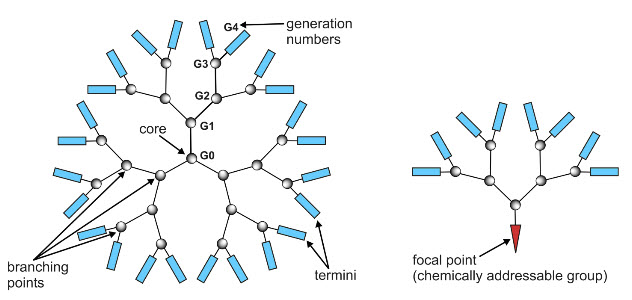
Structure
Dendrimers are built from a starting atom, such as nitrogen, to which carbon and other elements are added by a repeating series of chemical reactions that produce a spherical branching structure. As the process repeats, successive layers are added, and the sphere can be expanded to the size required by the investigator. The result is a spherical macromolecular structure whose size is similar to albumin and hemoglobin, but smaller than such multimers as the gigantic IgM antibody complex.
Dendrimers possess three distinguished architectural components (4,5), namely
(i) An initiator core.
(ii) Interior layers (generations) composed of repeating units, radically attached to the interior core.
(iii) Exterior (terminal functionality) attached to the outermost interior generations.
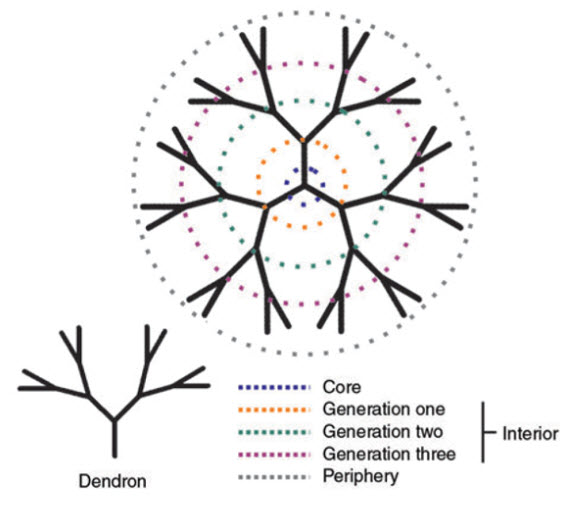
A 3DNA dendrimer is constructed from DNA monomers – as
The 3DNA monomer - the basic unit of dendrimer construction
Each 3DNA monomer is composed of two DNA strands that share a region of sequence complementarity located in the central portion of each strand. When the two strands anneal to form the monomer the resulting structure has a central double-stranded “waist” bordered by four single-stranded “arms” [Figure 1]. This “waist” plus “arms” structure comprises the basic 3DNA monomer. the name “3DNA” indicates.
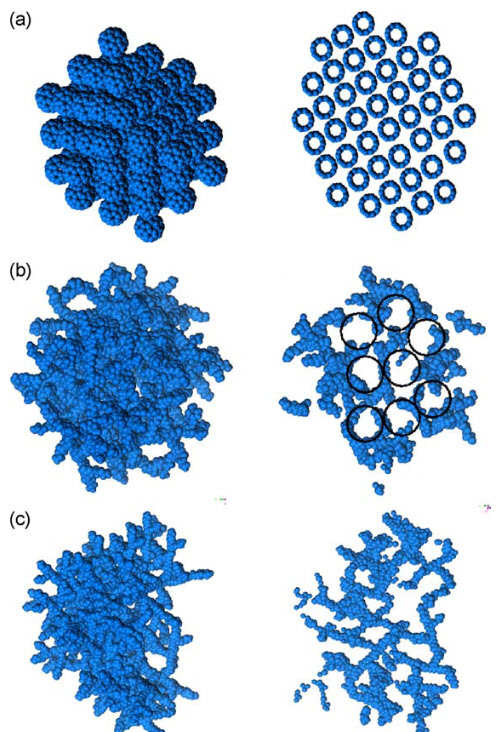
Fig. 2. 3D models (on the left) for (a) fullerene C60, (b) dendritic and (c) a hyper-branched PAMAM macromolecules. Slices cut trough the central part of the models are shown on the right. PAMAM dendrimers with the structure shown in (b) exhibit relatively open interior with cavities (big open circles) ranging from 5 to 15 A ° indiameter.
Linking monomers - the architecture of a 3DNA dendrimer
The single-stranded “arms” at the ends of each of the five monomer types are designed to interact with one another in precise and specific ways. Base-pairing between the “arms” of complementary monomers allows directed assembly of the dendrimer as a step-wise series of monomer layers [Figures 2A to 2C].
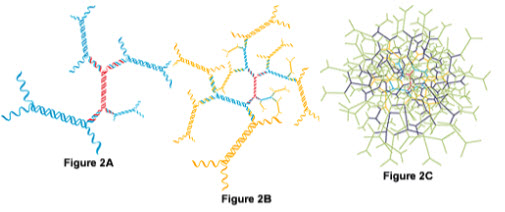
The layered structure of the 3DNA dendrimer
Construction of a 3DNA dendrimer begins with a single initiator monomer. To this, a first layer of monomers is attached by annealing the “arms” of the first layer monomers to the “arms” of the initiator monomer. The result is a one-layer 3DNA dendrimer with 12 single-strand “arms” available on its surface [Figure 2A]. This structure is then chemically crosslinked to prevent dissociation. Next, a second layer of monomers is attached to the first layer using the same interaction between the single-stranded “arms” of each component. In this two-layer 3DNA dendrimer the number of free single-stranded “arms” increases to 36 [Figure 2B]. A third layer of monomers is added in an analogous fashion, creating a total of 108 free single-stranded arms. Finally, in a perfect four-layer dendrimer, addition of the last set of monomers leaves 324 singlestranded “arms” on the surface of the molecule [Figure 2C]. As the dendrimer manufacturing process is not perfect, most dendrimers have fewer than 324 arms. An average dendrimer has about 250 arms, has a diameter of 150-200 nanometers, and consists of about 36,000 bases of DNA.
Using the “arms” for two functions – labeling and application specificity
The “arms” on the surface of the 3DNA dendrimer are used to attach the dendrimer’s two key functionalities. One function of the arms is to enable attachment of label. The other is to make the dendrimer specific to a particular application or experiment.
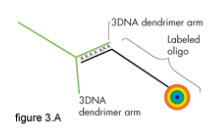
3DNA functionalities are attached with oligonucleotides
The molecules that determine the target and labeling specificity of the dendrimer are attached either as oligonucleotides or as oligonucleotide conjugates. Using simple DNA labeling, hybridization and ligation reactions, the 3DNA dendrimer scaffold may be converted into a highly labeled, applicationspecific probe [Figures 3A to 3C].
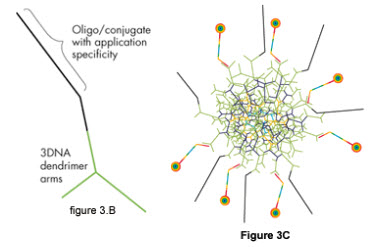
Flexible labeling and specificity
The architecture of the 3DNA dendrimer imposes no restrictions on the type of specificity or label used, so the dendrimer may be configured to meet a wide variety of detection needs. The label may be fluorescent, enzymatic, or radioactive.
Dendrimers are the few types of synthetic polymers thatcan be precisely controlled in size and structure. The well-defined structure renders dendritic macromolecules unique properties for versatile applications, especially in the biomedical field. For example, phosphorus-containing dendrimers have shown anti-prion activity and can potentially be used as mediators for gene therapy Boronated starburst PAMAM (i.e. polyamidoamine) dendrimer-monoclonal antibody immunoconjugates have been used as potentially efficient anti-cancer reagents involving boron capture of neutron. Commercially available dendrimers such as PAMAM and PPI (polypropyleneimine) dendrimer have also been employed as magnetic resonance imaging contrast agents potentially to improve the quality of the clinical diagnostics. They can be synthetically designed to mimic various biological functions of metalloproteins and enzymes such as supramolecular self-assembly, molecular recognition and complexation, etc. Because of their unique cascade architecture, dendrimers can coordinate with metal ions selectively on different structural locations such as the surface, core, or branching focal point. This distinct feature has attracted great attention among scientists in many disciplines including organic, inorganic, organometallic, polymer, physical and biochemistry as well as materials science. Unique magnetic, electronic and optical properties have been intensively explored in dendritic materials. Dendrimer research has indeed become an interdisciplinary topic with a great influence on wide fields of science and technology. This special dendrimer focus issue of Proceedings of the Royal Society A intends to highlight the most recent progress in the synthesis, properties and applications of dendrimers and to gather the innovative ideas among scientists involved in the dendrimer field, particularly those related to chemical and biomedical research. Therefore, we have invited the leading scientists in these fields to contribute their recent findings and developments of dendrimeric materials. Each article intends to present the multiple aspects and orientations that can potentially satisfy the multidisciplinary interests of our readers. This dendrimer focus issue contains six papers that have undergone a thorough peer-review process and cover the following wide range of topics: an overview on eight-year pursuit of the development of triazine-based dendrimers for potential therapeutic applications including infectious disease and cancer by E. E. Simanek (Texas A&M University; a novel organoplatinum antitumor prodrug based on the fourth generation PAMAM dendrimer for potential control-release of active platinum species in cancer treatment by B. Howell (Central Michigan University; an investigation on haemotoxicity of PAMAM dendrimers and the protective role of human serum albumin in haemolysis by B. Klajnert (University of Lodz; and a pre-clinical and behavioural toxicity profile of PAMAM dendrimers in mice by A. S. Chauhan (Dendritic NanoTechnologies Inc.
Types Of Dendrimers
Pamam Dendrimer
Poly (amidoamine) dendrimers (PAMAM) are synthesized by the divergent method starting from ammonia or ethylenediamine initiator core reagents. Products up to generation 10(7) (a molecular weight of over 9,30,000 g/mol) have been obtained (by comparison, the molecular weight of human hemoglobin is approximately 65,000 g/mol). PAMAM dendrimers are commercially available, usually as methanol solutions.
Pamamos Dendrimer
Radially layered poly(amidoamine-organosilicon) dendrimers (PAMAMOS) are inverted unimolecular micelles that consist of hydrophilic, nucleophilic polyamidoamine (PAMAM) interiors and hydrophobic organosilicon (OS) exteriors.
PPI Dendrimer
PPI-dendrimers stand for “Poly (Propylene Imine)” describing the propylamine spacer moieties in the oldest known dendrimer type developed initially by Vögtle.(8) These dendrimers are generally poly-alkyl amines having primary amines as end groups, the dendrimer interior consists of numerous of tertiary tris-propylene amines. PPI dendrimers are commercially available up to G5, and has found widespread applications in material science as well as inbiology. As an alternative name to PPI, POPAM is sometimes used to describe this class of dendrimers.
TectoDendrimer
These are composed of a core dendrimer, surrounded by dendrimers of several steps (each type design) to perform a function necessary for a smart therapeutic nanodevice.
Multilingual Dendrimers
In these dendrimers, the surface contains multiple copies of a particular functional group.
2.2.6 Chiral Dendrimers
The chirality in these dendrimersare based upon the construction of a constitutionally different but chemically similar branches to chiral core.
2.2.7 Hybrid Dendrimers Linear Polymers
These are hybrids (block or graft polymers) of dendritic and linear polymers.
2.2.8 AmphiphilicDendrimers
They are built with two segregated sites of chain end, one half is electron donating and the other half is electron withdrawing.
2.2.9 MicellarDendrimers
These are unimolecular micelles of water soluble hyper branched polyphenylenes.
2.2.10 Multiple Antigen Peptide Dendrimers
It is a dendron-like molecular construct based upon a polylysine skeleton. Lysine with its alkyl amino side-chain serves as a good monomer for the introduction of numerous of branching points.
Fréchet-Type Dendrimer
It is a more recent type of dendrimer developed by Hawker and Fréchet(6,8) based on poly-benzyl ethe
Synthesis
Dendrimers can be considered to have three major portions: a core, an inner shell, and an outer shell. Ideally, a dendrimer can be synthesized to have different functionality in each of these portions to control properties such as solubility, thermal stability, and attachment of compounds for particular applications.
METHOD 0F SYNTHSIS
dendrimer. There are two defined methods of dendrimer synthesis, divergent synthesis and convergent synthesis. However, because the actual reactions consist of many steps needed to protect the active site, it is difficult to synthesize dendrimers using either method. This makes dendrimers hard to make and very expensive to purchase. At this time, there are only a few companies that sell dendrimers;Divergent Methods Thedendrimer is assembled from a multifunctional core, which is extended outward by a series of reactions, commonly a Michael reaction. Each step of the reaction must be driven to full completion to prevent mistakes in the dendrimer, which can cause trailing generations (some branches are shorterthan the others)
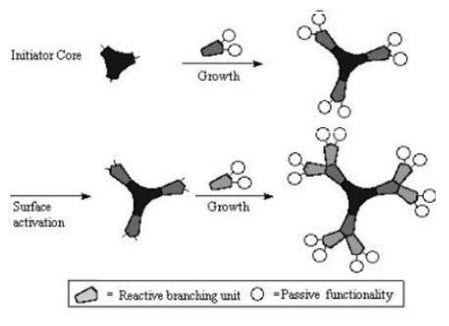
Divergent Dendrimer Growth
Convergent Methods
Dendrimers are built from small molecules that end up at the surface of the sphere, and reactions proceed inward building inward and are eventually attached to a core. This method makes it much easier to remove impurities and shorter branches along the way, so that the final dendrimeris more monodisperse. is more monodisperse.
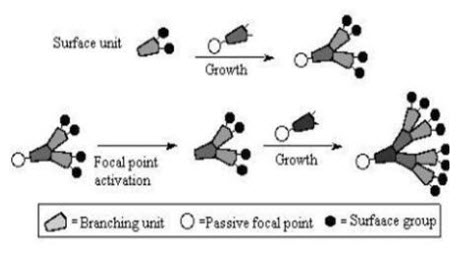
Convergent Dendrimer Growth
How do we make a dendrimer?
We make the nanodevice by modeling it first. Modeling then drives synthesis, which produces materials for testing. Test results, in turn, drive further modeling and synthesis.
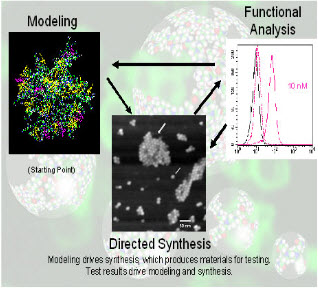
Dendrimers are built up in a layered way from a core. Below shows ethylene diamine. Each generation doubles the number of amines on the surface, on which to build the next generation. This shows Generation 3 or G3.
Current Applications
Inkjet Inks and Toners
PAMAM dendrimers, at low additive levels, dramatically improve water resistance and adhesion of inks to a variety of porous or nonporous substrates such as paper, glass, plastic, or metal. Their water and alcohol solubility permit formulation of low VOC inks. These polymers exhibit Newtonian flow behavior for shear stability in these formulations. In toners, they impart good admix and flow characteristics, stable properties, and high image quality.
In vitro Diagnostics
Dendrimer-antibody conjugates are used commercially in an immunoassay for rapid and sensitive detection of cardiac markers indicative of heart attacks.
In Vitro Gene Transfection
PAMAM dendrimers are used in in-vitro transfection of a broad range of cells with DNA. They form dendrimer:DNA complexes that provide reproducible high transfection efficiency and have low cytotoxicity.
Controlled Drug Delivery
A variety of molecules, such as drugs and other therapeutic agents, can be loaded both in the interior void space and on the surface of PAMAM dendrimers to control the rate of release of these agents into the body.
Promising Areas of Research
Gene Therapy
PAMAM dendrimers are highly effective agents for the delivery of genetic materials into a variety of cell lines. Both antisense oligonucleotides and DNA have been effectively delivered using these polymers. PAMAM dendrimers give no indication of inducing an immune response, show low in vitro cytotoxicity, stabilizepolynucleic acids against nucleases and an under-active investigation in genetic therapies.
Imaging
PAMAM dendrimer conjugates with paramagnetic ions are being studied for use as magnetic resonance imaging (MRI) contrastagents.Sensors
Due to their organized structure, ease of modification, and strong adsorption behavior to a variety of substrates, PAMAM dendrimers can be used to produce monolayers or stacked film layers, which can be used as sensors to detect hazardous chemical materials.
Nanocomposites
PAMAM dendrimers can form stable interior molecular nanocomposites with metal cations, zero-valent metals, other electrophilic ligands, and semiconductor particles. These materials are actively being investigated in electronics, optoelectronics and catalysis.
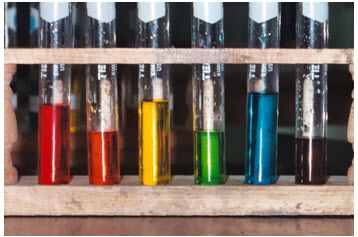
Organosilane Coatings
PAMAM dendrimers are the basis of poly(amidoamine) - organosilicon (PAMAMOS) coating technology. PAMAMOS coatings are tough, transparent, flexible coatings, which have many of the same attributes of PAMAM dendrimers in coating form. They are being investigated for applications in microelectronics.
Size Standards/Molecular Templates
The exceptionally uniform molecular size of the various PAMAM dendrimer generations enable their use as calibration standards or precise "scaffolds" and templates to make organized thin films and stacked layers.
References
- Deepayada , “Dendrimer : for novel drug delivery system – A review article”.
- ab Nanjwade, Basavaraj K.; Hiren M. Bechraa, Ganesh K. Derkara, F.V. Manvia, Veerendra K. Nanjwade (2009). "Dendrimers: Emerging polymers for drug-delivery systems". European Journal of Pharmaceutical Sciences (Elsevier) 38 (3): 185–196. doi:10.1016/j.ejps.2009.07.008. PMID 19646528.
- Deepayada , “Dendrimer : for novel drug delivery system – A review article”.
- Dendrimer a review of ther appeal and application – dykes 2001- Journal of chemical
- D. Astruc, E. Boisselier, C. Ornelas (2010). "Dendrimers Designed for Functions: From Physical, Photophysical, and Supramolecular Properties to Applications in Sensing, Catalysis, Molecular Electronics, and Nanomedicine". Chem. Rev. 110 (4): 1857–1959. doi:10.1021/cr900327d.
- Vögtle, Fritz / Richardt, Gabriele / Werner, Nicole Dendrimer Chemistry Concepts, Syntheses, Properties, Applications 2009 ISBN 3-527-32066-0
- Pushkar S, Philip A, Pathak K and Pathak D, “Dendrimers: Nanotechnology Derived Novel Polymers in Drug Delivery”, Indian J. Pharm. Educ. Res., 40 (3), 153-158, 2006.
- Sakthivel T and Florence A.T, “Adsorption of Amphipathic Dendrons on Polystyrene Nanoparticles”, Int. J. Pharm., 254, 23-26, 2003.
- .Yiyun C, Zhenhua X, Minglu M and Tonguen X, “Dendrimers as Drug Carriers: Applications in DifNilsen,T.W., Grazel, J., Prensky,W., Dendritic Nucleic Acid Structures, J. Theoretical Biology, 187:273-284 (1997).
- Capaldi, S., Getts, R.C., and Jayasena, S.D., A Signal Amplification Through Nucleotide Extension and Excision on a Dendritic DNA Platform, Nucl. Acids Res., 28(7):21e (2000).
- Wang, J., Jiang, M., Nilsen, T. W., and Getts, R., Dendritic Nucleic Acid Probes for DNA Biosensors. J. Am. Chem. Soc., 120:8281-8282 (1998).
- Wang, J., Rivas, G., Fernandes, J., Jiang, M., Lopez Paz, J.L., Waymire, R., Nilsen, T. W., and Getts, R., Adsorption and Detection of DNA Dendrimers at Carbon Electrodes.,Electroanalysis, 10(8):553-556 (1998).
- ferent Routes of Drug”, J.Pharma.Sci., 97(1), 123-143, 2008.
- M- NIMBS Michigan nanotechnology institute for medidines and biological science.
- Pushkar S, Philip A, Pathak K and Pathak D, “Dendrimers: Nanotechnology Derived Novel Polymers in Drug Delivery”, Indian J. Pharm. Educ. Res., 40 (3), 153-158, 2006.
- DHawker C and Fréchet J.M.J, “A new convergent approach to monodisperse dendritic molecule” J. Chem. Soc. Chem. Commun., 15, 1010-1012, 1990.
- 8.Hawker C, Wooley K.L and Fréchet J.M.J, J.Chem. Soc. Perkin. Trans ., 1, 1287-1289, 1993.
- 9. Frechet J.M.J and Tomalia D.A, “Introduction to the Dendritic state”, Dendrimers and other Dendritic Polymers, John Wiley & Sons Ltd, 24-23, 2001.
- Polymer Factory AB, Stockholm, Sweden.Polymer Factory
- abcHolister, Paul; Christina Roman Vas, Tim Harper (October 2003). "Dendrimers: Technology White Papers". Cientifica. Retrieved 17 March 2010..
- Dendrimer – Application. Htm
NOW YOU CAN ALSO PUBLISH YOUR ARTICLE ONLINE.
SUBMIT YOUR ARTICLE/PROJECT AT articles@pharmatutor.org
Subscribe to Pharmatutor Alerts by Email
FIND OUT MORE ARTICLES AT OUR DATABASE









